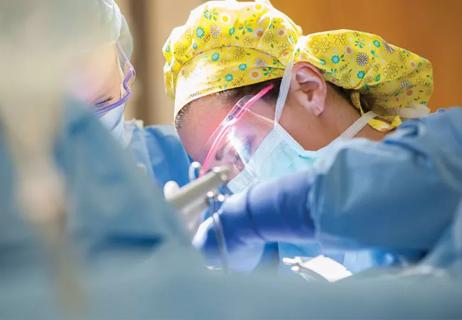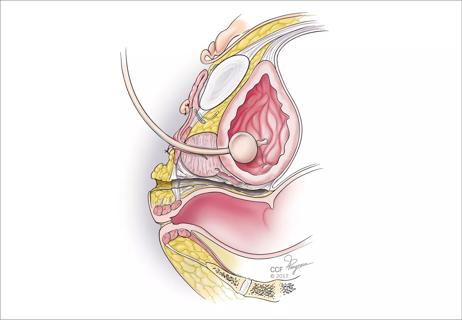Advertisement
How versican impacts extracellular matrix-dependent growth in uterine fibroids

By Ndeye-Aicha Gueye, MD; Timothy J. Mead, PhD; Christopher D. Koch; Charles V. Biscotti, MD; Tommaso Falcone, MD; and Suneel S. Apte, MBBS, D Phil
Advertisement
Cleveland Clinic is a non-profit academic medical center. Advertising on our site helps support our mission. We do not endorse non-Cleveland Clinic products or services. Policy
Leiomyoma (uterine fibroid) is the most common pelvic tumor occurring in women, affecting 70 to 80 percent of premenopausal women.
Abnormal uterine bleeding, pelvic pain and pressure, and a multitude of adverse reproductive outcomes are attributable to leiomyomas in up to 40 percent of women over age 35, causing significant impairment in their quality of life.
Leiomyomas are composed of abundant extracellular matrix, including collagen and versican, a large proteoglycan, rendering them fibrotic. While the precise molecular mechanism of leiomyoma development is not well understood, its growth is known to be dependent on ovarian hormones, estrogen and progesterone, as well as these hormones’ respective receptors, ESR1 and PR-A.
We became interested in investigating the impact of versican and its fragments on the behavior of leiomyoma and whether versican proteolysis in leiomyomas could help explain the pathogenesis of this disease, and perhaps offer new therapeutic directions. To accomplish this, members of the Ob/Gyn & Women’s Health Institute and the Biomedical Engineering Department, Lerner Research Institute, undertook an investigation of ADAMTS (a disintegrin and metalloproteinase with thrombospondin motifs) protease-mediated versican cleavage in myometrium and leiomyoma in symptomatic and asymptomatic women, as well as in immortalized myometrial and leiomyoma cell lines. Our study, Versican Proteolysis by ADAMTS Proteases and its Influence on Sex Steroid Receptor Expression in Uterine Leiomyoma, was published in The Journal of Clinical Endocrinology & Metabolism.
Advertisement
Tissue samples were collected from 14 women ages 43-60 who underwent a hysterectomy between January 2015 and February 2016. Women in both groups were similar in age, race, parity and menopausal status. Asymptomatic women in the study had hysterectomies for urinary incontinence and pelvic organ prolapse. Histology, RNA and protein analyses were performed on each sample.
The women in the symptomatic group had larger leiomyomas, heavy menstrual bleeding and lower hemoglobin levels compared with the asymptomatic group, but were similar in age and menopausal status. Versican isoforms were upregulated in the leiomyomas of symptomatic versus asymptomatic women. Abundant cleaved versican was detected in leiomyoma and myometrium, as well as in myometrial and leiomyoma cell lines. Knockdown of versican in leiomyoma cells did not affect cell proliferation, apoptosis or smooth muscle markers, but reduced expression of the sex hormone receptors ESR1 and PR-A.
Therefore, we conclude that versican present in myometrium, leiomyomas and in the corresponding immortalized cells is cleaved by ADAMTS proteases. Furthermore, when versican is suppressed, essential hormone receptors contributing to the pathogenesis of leiomyoma (ESR1 and PGR-A) are downregulated.
These findings illustrate the important role of versican and its effect in extracellular matrix-dependent leiomyoma growth. Future studies are needed to determine whether altering versican expression or cleavage offers a potential non-hormonal therapeutic approach for leiomyoma.
Dr. Gueye completed a fellowship in Reproductive Endocrinology and Infertility in the Ob/Gyn & Women’s Health Institute. Dr. Mead is a postdoctoral fellow and Mr. Koch is a graduate student in the Biomedical Engineering Department, Lerner Research Institute.
Advertisement
Advertisement

Deprivation is linked to impaired glucose intolerance and racial disparities

Artesunate ointment is safe well and tolerated patients with vulvar intraepithelial neoplasia

A case-based discussion of efficacy, eligibility and use

Workshop curriculum was valued by some, while others would have preferred time for themselves

Study finds lower incidence of endometriosis than in cisgender patients

Large randomized study compares embryo growth kinetics and live birth rates between culture media

Surgeon experience is key to reducing adverse events

Introducing Laura Detti, MD, newly appointed Chair of the Department of Subspecialty Care for Women’s Health